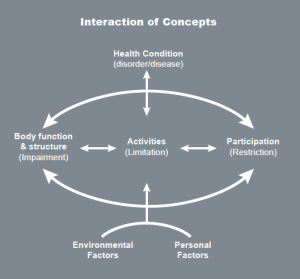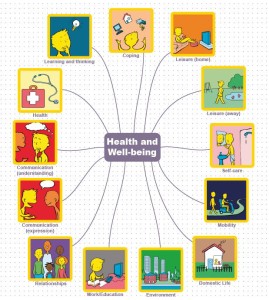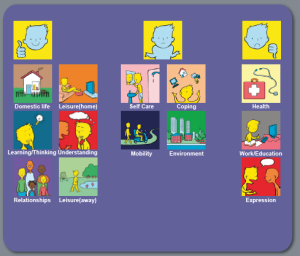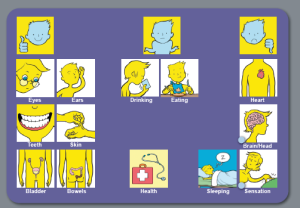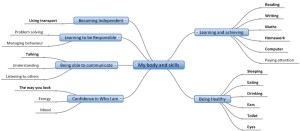The Health and Well-being resource is based on the WHO International Classification of Functioning, Disability and Health (ICF) which is a framework which covers almost every aspect of daily life and can be applied over different cultures (WHO 2001).
Use of the WHO ICF helps professionals to think holistically about the people they are working with. We have produced four sets of symbols, based on WHO ICF, to help people express their views about different aspects of their lives. These cover 13 topics:
You can use the symbols in different ways, depending on the cognitive abilities of the person you are working with. For example, if you are working with someone who can understand abstract concepts, you could start with the 13 main health and well-being symbols. Your top scale might be ‘managing’ and ‘not managing’. Here is an example of a mat completed by Duncan who had a stroke which affected his ability to communicate through speech:
Using these symbols as a starting point, Duncan could tell us that his main concerns related to worries about his health, expressive communication and work. From here, we did ‘sub mats’ to help Duncan identify the specific areas he wanted to work on/explore.
Here is the mat Duncan completed in relation to his health:
Having done this mat with Duncan, it became clear that he was worried about various aspects of his health, particularly the risk of having another stroke. The wider team were able to give him and his wife information about stroke prevention. Other mats were also completed, exploring expressive communication, work and education and higher level communication (which is included in the ‘learning and thinking’ topic, and covers written communication as well as memory and concentration). Using the Health and Well-being symbols, we were able to work with Duncan to help him identify the main issues that he wanted to work on and then work towards more specific rehabilitation goals. Duncan had copies of all the mats he had completed and found it useful to refer to them over the months. This helped everybody stay on track in relation to his goals and he was also able to track his progress over time.
Have a look at our Health and Well-being resource on our website. It is available both as an original Talking Mat with a physical mat and symbol cards or as a digital version as part of The Talking Mats pro subscription
I like my iPad and I LOVE the new Talking Mats app.
My 89 year old mum lives on her own about 2 hours from where I live and enjoys looking at photos on my iPad Mum has ‘all her marbles’, as the saying goes, and freely expresses her extreme views on current affairs, politics and photographs in Hello magazine! More difficult however, is discussing her failing energy levels and physical strength. She has till now resisted all suggestions of moving house to somewhere with more support.
I knew she would be interested in the Talking Mats app and a demonstration one afternoon flowed naturally into the Domestic topic of the Health and Well Being section. Suddenly we were in the middle of that difficult conversation we’d both been avoiding. Mum fully engaged with the app and changed the position of some items after consideration
The reality is she isn’t managing, she’s struggling. For the first time using the Talking Mats app she confessed to all domestic tasks being difficult even with the bits and pieces of help going in regularly.
The app made that bit easy. Making a decision about the next step will be more difficult.
Rhona Matthews
Guest Blog by Ruth Cape
Ruth is Lois Cameron’s daughter and she has contributed the following guest blog about her recent experience of taking and passing her driving test and how using a Talking Mat the night before her test developed a nerve controlling action plan!
My Driving test -a nerve wracking prospect
Even the simplest of actions within the context of a nerve-wracking event can be magnified to stomach churning proportions. The thought of opening a car door and putting on a seatbelt has never before given me much trouble. Now suddenly I’m imagining fumbling with the handle, not finding the seatbelt lock – or worse, forgetting the thing altogether; while trying to look cool and collected in front of a reportedly ‘no-benefit-of-the-doubt’ driving test examiner. It was the night before my practical driving test. I had recently failed on a nerves-getting-the-better-of-me manoeuvre and knew I’d be unlikely to get another test for 3 months if this one didn’t work out. I live on the Isle of Harris. Winter gales make cycling difficult, if not often impossible. Winter busses are sporadic. My housemate-cum-chauffeur-cum-co-driver had just left the island. My driving lessons in Stornoway required a four hour round trip. To put it lightly, I was pretty keen to pass. If I’m honest, even if I knew I could get another test the next week and if my day to day life wouldn’t be much effected by the use of a car, simply the thought of 40 minutes in that vehicle-turned-pressure-cooker, every move scrutinised by a stranger in a high-vis would have given me the tangled stomach I suffered from that test eve.
Talking Mat trialled as a pre-driving test nerve-gatherer
Timing was on my side this time round; my mum – Lois – and her colleague – Sally – happened to be on a Talking Mats training visit to Stornoway that pre-test day. Finished with a day of training, we met for dinner and, as plates were cleared away and calming herbal tea was ordered, out came the pen, paper and post-it notes. This – I gather – was the first Talking Mat trialled as a pre-driving test nerve-gatherer; proving just how versatile a tool it is. With a top-scale to gauge my confidence levels, different aspects of the test were handed to me and ended up in a cluster around the lower two steps of the scale; opening the door and putting on my seatbelt sat just a little above parallel parks and three point turns. While this mostly went to show that it was the whole experience that was knotting my insides, it allowed a valuable opening for discussion on how to go about unknotting, or at least concealing the knots.
Reframing thoughts and strategies for success
Re-framing the nerves to focused adrenalin, positive mantra, power posing and deep breaths – the mediation of the Mat provided the opportunity to work through strategies for success. I went to bed, glad – at least – to have had something to do to that evening to channel the nervous energy. The following morning I opened that car door, put on my seatbelt and proceeded to pass with one minor. Now, I can’t allow Talking Mats to take all the credit for this turn of events, but I can definitely praise the tool and thank my two informal practitioners for keeping me focused. From this experience, I’m sure there is potential for a wider Talking Mats scope for tackling anxiety and for use in relation to stressful situations.
Now Harris has opened up, and I’m off to explore…
The following are thoughts from Jenni, a Psychologist who attended the Talking Mats Accredited training course.
‘Meeting with five colleagues from Sweden, England and various parts of Scotland for the accredited Talking Mats Training this month has been a fascinating experience. I have been accustomed to using Talking Mats with children and young people over the past seven years, and have seen the value of the approach in helping young people give their views for a meeting – particularly if they have communication difficulties and would struggle either through lack of confidence or skill to speak out when others are present.
However, we were not just a group who work with children and young people. Most came from health settings and examples were drawn from elderly patients, some with dementia, others with autism. As we shared our videos and told our stories it was obvious to me how relevant Talking Mats can be in those settings too. Some of the stories shook me. One person told how she was deep in conversation with a lady over her Talking Mat when the tea lady burst in, poured a cup of tea for the resident, asked if she was having a good time playing at puzzles, then left before any answer could be given. Time and again we found ourselves asking what is it about our institutions that puts routines above real communication and above proper respect for an individual.
In preparing a video to bring to the training I undertook a Talking Mat with my father, who is almost 90. It was a new kind of conversation for us both, but we were surprised – the structure allowed us to talk about what was going well and what needed a bit of an adjustment in domestic life and we both learned from the conversation. I think we will do it again!
Indeed, at one stage in the training we were asked to dream big and look at how we might want to take use of Talking Mats into new areas. I identified some good friends – one 91, one 101 and one 104 – where conversation can become rather one-sided. I am interested in the power of Talking Mats to help create a genuine dialogue when these friends are reminiscing, in other words, to help me to be not just a listener but to enter the dialogue. Having a record of the conversation will help us take the discussion further when we return to it.
As ever, the time spent with Talking Mats colleagues was refreshing, stimulating and I can’t wait to go home and try out some new ideas!’
Jenni Barr, Educational Psychologist
During the final stages of developing Digital Talking Mats, we invited some people with aphasia and their partners to come and try it out for us. I spent some time talking to Matthew, who has severe global aphasia and dyspraxia. Matthew loves having a chat, but relaxed conversation can be a challenge because Matthew finds it difficult to generate language and sometimes his yes/no responses get mixed up. I used the ‘activities’ topic with Matthew to have a chat about the things he likes (and doesn’t like) doing. Matthew found the Digital Talking Mats easy to use and quickly gave me his views about activities. Using the i-pad made the conversation feel very natural, and Matthew was able to convey his sense of humour – when I asked him about Church; Matthew started to sing the Funeral March! We had quite a laugh about this, and it turned out that at the moment, Matthew really only goes to Church when there is a funeral. Matthew was also able to tell me about things that he finds difficult since his stroke, such as reading and doing DIY. During our conversation, I was struck by how equal the conversation felt. Matthew was able to express his views without feeling pressurised to think of words. I was able to ask Matthew open questions without worrying that I might not understand his responses. Using Talking Mats on the i-pad was easy and relaxed. I could imagine using it with Matthew to have a chat over coffee or at the pub. Perhaps we should think of some conversational symbol sets?
To see Matthew using the app, click here
We wanted to develop a tool that would give a holistic picture of how a child or young person feels about their lives at home at school and in their communities. We took into account the significant developmental changes that occur from 3 to 17 years and the influence of environmental and personal factors surrounding the child or young person.
We asked our artist to reflect the age and stage of the child in developing a symbol set for:
- Early years
- Primary and
- Secondary
The symbols are organised into three topics:
My Body and Skills: In this section you explore how the child is growing and developing by focussing on the functions of the body as well as skills that are emerging. You can gain an impression of how the child feels he or she is progressing physically, socially, cognitively and behaviourally.
What I do and my support: In this section you look at the child’s lived experience by asking about the activities they participate in, as well as how they feel about the support they receive.
My Wider world: The communities in which children grow up have a significant impact on the well-being of both children and families. In this section you look at the child’s wider world by exploring the impact of nursery or school as well as the support system available to them.
Talking Mats prompts you to cover the relevant topics for each age group you’re working with. You can help children and young people to see their personal strengths and abilities and take time to consider what their problem areas are.
The mind map below shows what is included in the Primary pack – What I do and my support.
If you want to read about how Talking Mats were used to help young people think about targets for their IEP read the 2012 research report.
If you would like the complete Consulting children and young people pack, covering Early years, Primary and Secondary then buy the silver resource which can be purchased either as an original or through a digital subscription.
Speech presented at the launch of new Talking Mats Resources
Hello everyone, my name is Greig McMurchie and I would like to take the opportunity to welcome you all here today. If I look familiar it may be because you recognised me from the original talking mat video, where I had a cameo appearance with the lovely Joan murphy of course that was over ten years ago, and back then I was much younger and better looking. Joan however is still as lovely as the day I met her.
As you can see, I have been involve in talking mats for many years now, ever since Joan asked me to help her trial a new communication system, that she and her colleague Lois had been developing. My initial thoughts were wow, this sounds really complicated and I was a little bit scared. But I had known Joan since I was little and I really wanted to see what this new Communication system was all about.
When Joan came to visit me at that Dundas day center, all those years ago, all my fear quickly disappeared, it was really easy. I was able to have my say, and because it was visual I could change my mind also. I began using talking mats to share my views, opinions and wishes, and before long this system was helping me to make life Changing decisions, such as what I wanted to do with my life once I had finished my college course. In fact you could argue that I am where I am today because of talking mats. And I like to say I wouldn’t have it any other way.
Anyway, that was away back then, and times have move on. About four weeks ago Joan and Lois came to Upper Sprinlands to visit me, and of course show me their wonderful bran new talking mats app. My initial thoughts were this sound fantastic, and when they arrived we had a wee chart and they explained what they had been doing.
I don’t know about everyone else, but when I was a kid a tablet was something you took if you were not feeling too well, an android was a character from a computer game and an apple was something you gave to your teacher to butter them up if you forgot to do your homework. But today all this modern technology is making it easy for everyone to engage creating doorways to all kinds of wonderful stuff. And boy can I say this new talking mats app is all kinds of wonderful.
So after we chatted I got to have a wee play with the new app, I couldn’t believe how easy it was, you were able to just move the pictures around and place them were you want them on the screen. The New picture sets are fantastic, they are bright colourful and easy to understand. I also like the way you can enlarge the picture to make it easier to see. And of course the fact that it come already to use. You can even take a photograph and send it to yourself by email. No more printing, cutting out and Velcroing, no more hunting for the camera only to realize the batteries are flat and you can’t use it anyway. Everything is just nicely packaged. And the fact that it can be used not only on an Ipad but also on a computer makes it even more accessible.
Dare I say I personally felt the new App for me was even easier than the old system; it is quicker, fun and very cool? Now I just need to persuade Upper springland to Purchase a copy or twelve.
Thank you talking Mats
(Speech at the Launch of the New Talking Mats Resources )
One of the things I love about Talking Mats is that it can be used by all agencies. When thinking about the rationale behind GIRFEC the main focus is to encourage professionals to work together. It is so refreshing to have a resource that is recognised and used across the agencies.
It is not necessary to have written reports with names of assessments or measures that are a mystery to each other. Talking Mats uses visuals to capture feelings and views. The reporting of those views can be understood by children, parents and professionals.
In developing our new resource we listened and responded to a wide range of professionals. We have researched the Well-being indicators and have provided a tool to give an overview of the issues in the lives of children and young people.
Our vision is to provide a tool to listen to and capture children’s voices. We have a responsibility to be open and realistic about how we respond to what they tell us. Taking time to listen means we need to take time to respond.
We hope that Talking Mats will improve understanding throughout the whole GIRFEC team as we seek to get to the heart of what matters to the child. Margo Mackay
(more…)
I want to go on holiday on my own!
At a recent training Jenn Hall who is a Personalisation Development Worker, told the story of her first use of Talking Mats. She used it with a woman that she has known for some time to discuss her views about her going on holiday. The lady is in her forties and has Downs Syndrome. As she came to the people symbol she looked at it for ages and then placed it in the middle column explaining that she wanted to go on holiday on her own and visit her brother who lives in Spain without her parents. she had never been supported to do this and it was what she really wanted to do. She also put the food in the middle column explaining that it was hard to understand the menus when she was abroad and that she wanted to learn a few basic words in Spanish. Jenn said that the Talking Mats really enabled the lady to express what she wanted not just go along with the status quo and for those around her to appreciate and understand her views . The Talking Mats has supported discussion with the family to enable this lady’s wish to come true . Hopefully she will have her first successful holiday with her brother visiting him all by herself.
At our recent accredited training Anne Lafferty form the Advocacy Project Glasgow described how she used Talking Mats in a group setting. She had been asked to work with a group of adults with mental health difficulties who lived together in a house but found it a challenge to relate to each other. She decided to use Talking Mats with a data projector plus lots of paper and glue . The topic was what activities they were interested in participating in and what Anne did was project each symbol one at a time onto the screen and then everyone placed their own symbol onto their own paper Mat. She said this worked really well, the image of the symbol projected onto the wall held the groups attention but everyone had their chance to express and then share their views. Apparently the staff were amazed and really pleased about how well the tenants participated, stayed and listened to each other. Thought it worth sharing this easy and creative way to use Talking Mats in a group setting – thanks for the idea Anne
 Online training login
Online training login 

